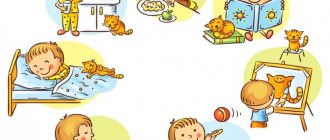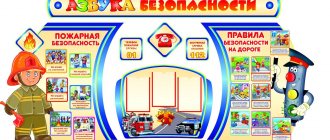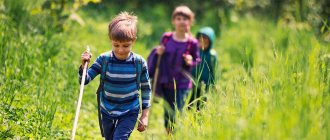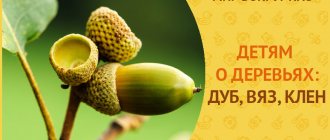Drawn pictures
Any product drawings are excellent material for:
- speech games;
- conversations;
- speech therapy exercises.
It is useful to use together both sets of subject cards with images of food and plot pictures of this topic.
Healthy and unhealthy food products are shown separately in pictures for children; it is important to teach children to easily distinguish between them.
Cards with drawn pictures are suitable for:
- classes;
- games;
- exercises.
Oil
Cheese Dairy products
Meat
Sausages Canned food
Bread
Cereals, pasta
Cookies, bagels, crackers
Rules for speech therapy classes at home
The success of home lessons depends not only on the availability of the necessary aids and a work plan agreed upon with the speech therapist. The organization of classes itself is very important. Here are a few simple rules that will help you achieve excellent results:
- All speech therapy exercises for children should be carried out regularly, but a little at a time. You shouldn’t try to do articulation gymnastics, play speech games, or fill out a workbook right away. It is better to devote a few minutes to each type of exercise, rather than having a whole “speech therapy day.”
- Do not force them to complete tasks under pressure; educational activities for children should resemble a game. Come up with a simple plot (for example, a journey into the universe of sounds), prepare small prizes (stickers, paper stars), and arrange physical exercises.
- Praise and support the little student if he makes even the slightest progress. Focus on achievements, even small ones, gradually progress will become more and more obvious.
- Find good workbooks for home practice. They should not only be professional in content, but also bright, colorful, and exciting. It is ideal if the tasks have interactive elements (the opportunity to add something, draw something). Such material makes it possible to interest a preschooler and clearly shows him the “path traveled” and success.
- Don't expect instant results, be patient and gentle perseverance. The process of setting, consolidating, and differentiating sounds is complex; it takes months even for experienced speech therapists. Follow the plan and the results will gradually appear.
Doman cards
Use Doman's cards in speech development classes on the topic Products. Bright, clear images with text can be used in games and exercises.
You can also use photos of food. It is important to choose those that have a neutral background, preferably a light one. Of course, photographs should be printed in advance and pasted onto cardboard.
Speech therapy tasks
Starting with the letter R
One of the most difficult sounds to master is R. Many preschoolers learn to roar loudly by the very end of kindergarten. If the production of the sound P is already behind you, then special exercises will help speed up its automation:
1. “Like a little motor”
We ask the child to pronounce the sound R in the word for a long time, drawlingly (like a motor growls).
2. “Where is R hiding?” (in pictures and words)
Offer to choose pictures with images of objects with a given sound or clap your hands if he hears such a word.
3. “How can you growl?”
Show your child pictures of objects that have the sound r in their names. Offer to read and color the picture.
4. “Sounding tracks”
Together with your child, come up with several chants made up of several syllables:
Ra-ra-ra - they ran away from the yard.
Ro-ro-ro - and they found a bucket.
Ru-ru-ru - we came up with a game.
5. “Substitute a syllable”
The adult offers the child words that end or begin with a syllable with P (ra, ro, ry), the child must choose the correct option and pronounce it correctly.
6. “Look and name”
An adult asks the child to read words with the letter r from the pictures. The word must be said as many times as there are stars next to each picture.
7. “Poems, tongue twisters, riddles”
Learn with your child several poems and riddles in which words with R appear.
The necessary tasks for speech development can be found in the Workbook for the sound R, compiled by Kostyuk A.V.
Download, print the tasks in pictures and study at home:
Speech therapy tasks for the letter P
Starting with the letter L
The hard sound L is also often difficult for children 5-6 years old. If the baby has already learned to pronounce it alone, in isolation, then it’s time to start working on automation in speech. The following exercises are suitable for this:
1. “Say it nicely”
Offer your child several images of words starting with L. Ask him to pronounce the words beautifully, emphasizing the desired sound with his voice.
2. “Toys for Larisa”
Ask your child to collect gifts for the Larisa doll. Tell her that she only likes things that begin with L. For this exercise, you need to select small objects or pictures in advance; all words should not begin only with L.
3. “One-many”
Invite your child to name words with L in the singular and plural. In the workbook for the sound L (author Kostyuk A.V.) there is a whole table with pictures for this exercise (lesson 20).
4. “Find the Sound”
Invite your child to draw up a diagram of the word and mark the place L on it. If it is still difficult for your child to independently determine the number of sounds, then first you can do several similar exercises from the workbook.
5. “Tongue twisters and nursery rhymes”
Use nursery rhymes, tongue twisters and poems with words that contain L.
Download and print tasks in pictures starting with the letter L:
Speech therapy tasks for the letter L
Story pictures
Use story pictures to compose stories with children in the classroom. For these purposes, plot paintings on the themes: “Grocery supermarket”, “At the vegetable market”, “First cucumber”, “Cooking with mom”, “How the orchard feeds us in winter” are suitable.
Typical speech disorders in children 5-6 years old
Most older preschoolers have difficulties with:
- mastering sonorous and hissing sounds;
- sound analysis of words;
- development of narrative speech;
- writing a story and descriptions.
Of course, such problems can be minor, only slightly different from the age norm, or serious, up to and including general speech underdevelopment (GSD). It is necessary to contact a speech therapist in any case, but the supportive work of parents at home is also very important.
It is worth noting that regular speech therapy exercises and classes for children 5-6 years old are useful for every child at home, because they help to master literacy faster.
Coloring pages
Speech therapists and teachers always use thematic coloring books to develop a child’s speech. Regular coloring not only helps children enrich their vocabulary and learn new grammatical structures, but also helps train fine motor skills, which, in turn, greatly helps activate the speech centers of the child’s brain.
Use pictures of Unhealthy Foods for children to color, this will not only improve speech skills, but also form an understanding of the basics of healthy eating and reasonable dietary restrictions. After coloring, you can have a conversation on the topic “The benefits and harms of the foods we eat.” It is easy to make a small presentation or collage from children's drawings, which can serve as additional visual material.
Learning to read. Pictures instead of words. Continuation
Children like to read funny texts where some words are replaced with pictures. At the learning stage, it is important to interest the child, to diversify the material not only in subject matter, but also in presentation. Today’s selection is suitable for children who are already familiar with the materials in the article “ Learning to Read.” Pictures instead of words." The continuation will be even more interesting. Here, not only reading skills are trained, but other speech and cognitive processes are also developed. For ease of selection, the texts are grouped into sections, whose names you can easily understand how the stories differ.
Training
Just keep reading stories with pictures. These texts are quite large in volume . They are a little difficult for beginners to master. However, you can get involved in the reading process at any stage and help your child.
Helper for adults
Quality. The previous article talked about texts that should be avoided. In addition, I will say that the pictures themselves are illegible. Either the image resolution on the computer is low, or an unsuccessful option was chosen to transfer the image to digital format (photography, scanner, webcam). Therefore, I recommend printing materials from the Internet onto an A5 sheet or 2 images per A4 sheet.
Unfamiliar pictures. If the child does not recognize the objects depicted or does not yet know what they are, you have a wonderful opportunity to educate the baby. Don't forget a previously unknown word (let's say it's violin). After reading, find relevant information in the children's encyclopedia (what is a violin, what does it consist of, who uses it and how). Select a few good photographs or paintings (orchestra, young musician). Find an audio recording, video, cartoon (“First Violin”) or presentation. The best option is to introduce a real object or living creature.
Sounds and letters
Onomatopoeia while reading is a playful moment, a short break. Ask your child to repeat the sounds that are in the story.
to better memorization of letters . This includes depicting a letter using your own body, laying it out from small objects, feeling and examining the elements of a plastic alphabet. Another option is to search for similar objects in the surrounding world for visual reinforcement. The following story is a great example of this.
Stickers
Many children's magazines publish stories where you need to paste pictures into the text. Why not make these stickers yourself? All you need is text with gaps and missing small images. The catch with these puzzles is that with all the arsenal of pictures, it’s not so easy to navigate through the text and choose the one you need. This is a difficult task, because there are no contour clues, only semantic ones in the text (adjectives, for example). The previous tasks can be completed by beginning readers. This will require the help of an adult or a reading level at which the child understands the meaning of what is being presented very well.
Here are the answers to the two previous pages, although the option chosen by your child can be very successful and funny.
Riddles and questions
The child read the story, but did he understand its content? Offer him stories with questions, let him try to answer. Like any other problem or riddle, this exercise trains thinking, which is especially important, precisely in conjunction with speech.
The task activates not only reasoning skills, but also attention to detail. Is it easy for you to answer us?
Which animal wore which mask? Why do you think so?
Fun and jokes
One of the indicators of normal child development is the ability to understand humor and respond to it. Of course, the categories of humor are very diverse, and jokes of a rather narrow range are useful for children. For example, these are various absurdities, absurdities, funny situations and puns. Offer your child the following stories with humor.
A child draws a fairy tale
The most creative version of playing with texts is when the child is given a template story , and he comes up with characters and details. You definitely won’t find identical stories. We can say that this is a page forgotten by the storyteller, or that the words from the fairy tale were stolen by a thief, and they need to be restored. Advantages of texts with disappeared pictures:
- An excellent imagination stimulator and a chance to draw. It doesn’t matter how well the child has drawing skills, the main thing is his desire to bring something of his own to the fairy tale. His imagination will tell him.
- Self-realization. All desires and dreams will instantly appear on the page from under the pencil of the young writer. Be attentive to these stories: they are like a door into the inner world of a child. Refrain from criticizing the plot and the options chosen by your child, so as not to discourage him from creating.
- Fairytale therapy. As an option for working out internal experiences or reflecting worldview, drawings work great. A fairy tale can always be discussed and continued, leading to a positive conclusion. The child is structured in such a way that the world of fantasy easily fits into reality and vice versa. Let's say there is a fear of the dark, you can defeat it in a fairy tale and transfer the experience to reality (buy a “magic lantern” that drives away fear).
- Multiple options. Use one text several times, and when the first plot is forgotten, return to writing again.
- Development of fine motor skills and hand writing skills. The drawings here are quite small, sometimes they need to be duplicated, so practicing with a pencil will be excellent. It is not necessary, but it is advisable for the child to place the image in a limited area (after all, he will continue to need to follow the margins in the notebook and the lines when writing).
- Entertainment. Organize an evening of homemade fairy tales in a children's group. While composing a text from start to finish is sometimes difficult for many guys, everyone can make a few inclusions to suit their taste. The results are unique, very funny texts.
- Activation of visual-motor memory. Small drawings are great for remembering and are a great tool for practicing. Short phrases with pictures as reference points create the backbone for the retelling.
- Increased self-confidence. How nice it is to tell a fairy tale that you wrote yourself. I didn’t read it in a book, I heard it in a recording, and so on. Encourage your child's desire to read his story to friends, family and acquaintances. Let him feel like both a writer and a reader.
From my own experience I will say: having become acquainted with a new way of presentation, I want to write and draw myself. A little children's trick: you don't know how to write a word yet, you can sketch it.
The first two fairy tales somewhat limit the child’s choice to familiar phrases; the subsequent ones are deliberately created with a large number of options. The fairy tale is suitable for girls, and the story about helping an ant is suitable for boys, but this is more of a recommendation. All texts are completed with questions and tasks for children, so that even after reading the game does not end.
Keep these fairy tales as sweet and pleasant memories dear to your heart.
Important!
At the end of the article you can download the file “Tales with spaces”. You will receive 4 stories in text format that are easy to print and start creating with your child.
If your child has difficulty drawing, then in one of the following articles you will find material for developing fine motor skills through drawing. A few simple visual techniques will allow you to draw animals, plants and much more. Then the baby will easily fill in the gaps in fairy tales.
At the end of the article, a short digression for adults. It’s done funny, as if we remembered it from children’s magazines or we are again trying to find a common language with loved ones and learning to read pictures instead of words. The continuation of the story is unknown. Have a good mood and enjoy reading with your child.
Download files
Skazki_s_probelami_pro_feyu
Skazka_s_probelami__Pro_muravya
skazki_s_probelami
skazki_s_probelami_2
PS Happy reading and creativity to you and your child!
Child psychologist
Anna Zubareva
For advertising purposes:
Do you want to know how to properly teach your child at home? Subscribe to site updates and you will always know when a new article has appeared:
Share on social media networks
RќСЂР°РІРёС‚СЃСЏ
Related posts:
- Learning to read. Pictures instead of words The new school year has begun. Some of the kids are mastering difficult school...
- Talking about birds and drawing step by step We continue to get acquainted with new simple drawing techniques for children. AND…
- Drawing step by step. Forest Today's material is selected for children of different ages. Thanks to the picture instructions you...
- Summer. Observations of nature. Trees and shrubs The fertile time is summer. Observations of nature (trees and shrubs,…
- Autumn calendar. November Let's flip through our autumn calendar. It's time to welcome November. The eleventh month of the year ends...








